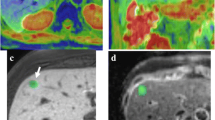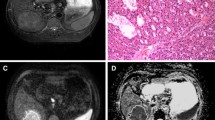Abstract
Purpose
The aim of this study was to investigate the relationships between values obtained from whole tumor volumetric apparent diffusion coefficient (ADC) measurements and histopathological grade in patients with hepatocellular carcinoma (HCC).
Methods
Fifty-one naïve patients with HCC were included in the study. The tumors were classified according to the Edmondson–Steiner grade and separated as well-differentiated and non-well-differentiated (moderately and poorly differentiated). The ADC parameters of groups were compared by applying Mann–Whitney U test. The correlation between tumors’ histopathological stage and whole tumor ADC parameters was investigated using Spearman’s Rank Correlation Coefficient. The receiver operating characteristic curve analysis (ROC) was applied to calculate the area under curve (AUC) with intersection point of ADC parameters and curve.
Results
Mean and percentile ADC values of well-differentiated tumors were significantly higher than those of non-well-differentiated tumors (p < 0.05). The strongest correlation between histopathological grade and ADC parameters was 75th percentile ADC (r = − 0.501), 50th percentile ADC (r = − 0.476) and mean ADC (r = − 0.465). Mean, 75th and 50th percentile ADC values used for the distinction of groups gave the highest AUC at ROC analysis (0.781, 0.781, 0.767, respectively). When threshold values of mean, 75th and 50th percentile ADC values were applied (1516 mm2/s, 1194 mm2/s, and 1035 mm2/s) sensitivity was calculated as 0.73, 0.91, 0.83, respectively, and specificity was calculated as 0.82, 0.61, and 0.68, respectively.
Conclusions
A correlation between whole tumor volumetric ADC values and HCCs’ histopathological grade was detected in this study. 75th percentile, 50th percentile and mean ADC values are determined as highly sensitive and specific tests when the threshold values are applied for distinguishing between well-differentiated tumors and moderately/poorly differentiated tumors. When all these findings are evaluated together, HCCs’ volumetric ADC values might be a useful noninvasive predictive parameters for histopathological grade in patients with HCC.
Graphic abstract





Similar content being viewed by others
References
Bray F, Ferlay J, Soerjomataram I, Siegel RL, Torre LA, Jemal A. Global cancer statistics 2018: GLOBOCAN estimates of incidence and mortality worldwide for 36 cancers in 185 countries. CA Cancer J Clin. 2018; 68(6):394-424. doi: https://doi.org/10.3322/caac.21492
McGlynn KA, Petrick JL, El‐Serag HB. Epidemiology of Hepatocellular Carcinoma. Hepatology. 2021; 73(S1):4-13. doi: https://doi.org/10.1002/hep.31288
Kudo M, Trevisani F, Abou-Alfa GK, Rimassa L. Hepatocellular Carcinoma: Therapeutic Guidelines and Medical Treatment. Liver Cancer. 2017; 6(1):16-26. doi: https://doi.org/10.1159/000449343
Colecchia A, Schiumerini R, Cucchetti A, Cescon M, Taddia M, Marasco G, et al. Prognostic factors for hepatocellular carcinoma recurrence. World J Gastroenterol. 2014; 20(20):5935-50. doi: https://doi.org/10.3748/wjg.v20.i20.5935
Likhitsup A, Parikh ND. Economic Implications of Hepatocellular Carcinoma Surveillance and Treatment: A Guide for Clinicians. PharmacoEconomics. 2020; 38(1):5-24. doi: https://doi.org/10.1007/s40273-019-00839-9
Edmondson HA, Steiner PE. Primary carcinoma of the liver. A study of 100 cases among 48,900 necropsies. Cancer. 1954; 7(3):462-503. doi: https://doi.org/10.1002/1097-0142(195405)7:3<462::aid-cncr2820070308>3.0.co;2-e
Zhou L, Rui J-A, Zhou W-X, Wang S-B, Chen S-G, Qu Q. Edmondson-Steiner grade: A crucial predictor of recurrence and survival in hepatocellular carcinoma without microvascular invasion. Pathol Res Pract. 2017; 213(7):824-30. doi: https://doi.org/10.1016/j.prp.2017.03.002.
Taouli B, Koh D-M. Diffusion-weighted MR imaging of the liver. Radiology. 2010; 254(1):47-66. doi: https://doi.org/10.1148/radiol.09090021
Granata V, Fusco R, Filice S, Catalano O, Piccirillo M, Palaia R, et al. The current role and future prospectives of functional parameters by diffusion weighted imaging in the assessment of histologic grade of HCC. Infect Agent Cancer. 2018; 13-23. doi: https://doi.org/10.1186/s13027-018-0194-5
Chang WC, Chen RC, Chou CT, Lin CY, Yu CY, Liu CH, et al. Histological grade of hepatocellular carcinoma correlates with arterial enhancement on gadoxetic acid-enhanced and diffusion-weighted MR images. Abdom Imaging. 2014; 39(6):1202-12. doi: https://doi.org/10.1007/s00261-014-0168-z
Wei Y, Gao F, Wang M, Huang Z, Tang H, Li J, et al. Intravoxel incoherent motion diffusion-weighted imaging for assessment of histologic grade of hepatocellular carcinoma: comparison of three methods for positioning region of interest. Eur Radiol. 2019; 29(2):535-44. doi: https://doi.org/10.1007/s00330-018-5638-1
Kwon H-J, Byun JH, Kim JY, Hong G-S, Won HJ, Shin YM, et al. Differentiation of small (≤2 cm) hepatocellular carcinomas from small benign nodules in cirrhotic liver on gadoxetic acid-enhanced and diffusion-weighted magnetic resonance images. Abdom Imaging. 2015; 40(1):64-75. doi: https://doi.org/10.1007/s00261-014-0188-8
Thust SC, Hassanein S, Bisdas S, Rees JH, Hyare H, Maynard JA, et al. Apparent diffusion coefficient for molecular subtyping of non-gadolinium-enhancing WHO grade II/III glioma: volumetric segmentation versus two-dimensional region of interest analysis. Eur Radiol. 2018; 28(9):3779-88. doi: https://doi.org/10.1007/s00330-018-5351-0
Barrett T, Lawrence EM, Priest AN, Warren AY, Gnanapragasam VJ, Gallagher FA, et al. Repeatability of diffusion-weighted MRI of the prostate using whole lesion ADC values, skew and histogram analysis. Eur J Radiol. 2019; 110:22-29. doi: https://doi.org/10.1016/j.ejrad.2018.11.014
Bougias H, Ghiatas A, Priovolos D, Veliou K, Christou A. Whole-lesion apparent diffusion coefficient (ADC) metrics as a marker of breast tumour characterization—comparison between ADC value and ADC entropy. Br J Radiol. 2016; 89(1068):20160304. doi: https://doi.org/10.1259/bjr.20160304
Ameli S, Shaghaghi M, Aliyari Ghasabeh M, Pandey P, Hazhirkarzar B, Ghadimi M, et al. Role of baseline volumetric functional MRI in predicting histopathologic grade and patients’ survival in hepatocellular carcinoma. Eur Radiol. 2020; 30(7):3748-58. doi: https://doi.org/10.1007/s00330-020-06742-8
Kudo M, Kitano M, Sakurai T, Nishida N. General Rules for the Clinical and Pathological Study of Primary Liver Cancer, Nationwide Follow-Up Survey and Clinical Practice Guidelines: The Outstanding Achievements of the Liver Cancer Study Group of Japan. Dig Dis. 2015; 33(6):765-70. doi: https://doi.org/10.1159/000439101
Moriya T, Saito K, Tajima Y, Harada TL, Araki Y, Sugimoto K, et al. 3D analysis of apparent diffusion coefficient histograms in hepatocellular carcinoma: correlation with histological grade. Cancer Imaging. 2017; 17(1):1. doi: https://doi.org/10.1186/s40644-016-0103-3
Xu Y-S, Liu H-F, Xi D-L, Li J-K, Liu Z, Yan R-F, et al. Whole-lesion histogram analysis metrics of the apparent diffusion coefficient: a correlation study with histological grade of hepatocellular carcinoma. Abdom Radiol. 2019; 44(9):3089-98. doi: https://doi.org/10.1007/s00261-019-02109-w
Woo S, Cho JY, Kim SY, Kim SH. Histogram analysis of apparent diffusion coefficient map of diffusion-weighted MRI in endometrial cancer: a preliminary correlation study with histological grade. Acta Radiol. 2014; 55(10):1270-7. doi: https://doi.org/10.1177/0284185113514967
Metens T, Absil J, Denolin V, Bali MA, Matos C. Liver apparent diffusion coefficient repeatability with individually predetermined optimal cardiac timing and artifact elimination by signal filtering. J Magn Reson Imaging. 2016; 43(5):1100-10.
Wirestam R, Borg M, Brockstedt S, Lindgren A, Holtas S, Stahlberg F. Perfusion-related parameters in intravoxel incoherent motion MR imaging compared with CBV and CBF measured by dynamic susceptibility-contrast MR technique. Acta Radiol 2001; 42(2): 123–128.
Author information
Authors and Affiliations
Corresponding author
Additional information
Publisher's Note
Springer Nature remains neutral with regard to jurisdictional claims in published maps and institutional affiliations.
Rights and permissions
About this article
Cite this article
Piskin, F.C., Balli, H.T., Erdoğan, K.E. et al. Whole tumor volumetric ADC analysis: relationships with histopathological differentiation of hepatocellular carcinoma. Abdom Radiol 46, 5180–5189 (2021). https://doi.org/10.1007/s00261-021-03240-3
Received:
Revised:
Accepted:
Published:
Issue Date:
DOI: https://doi.org/10.1007/s00261-021-03240-3




